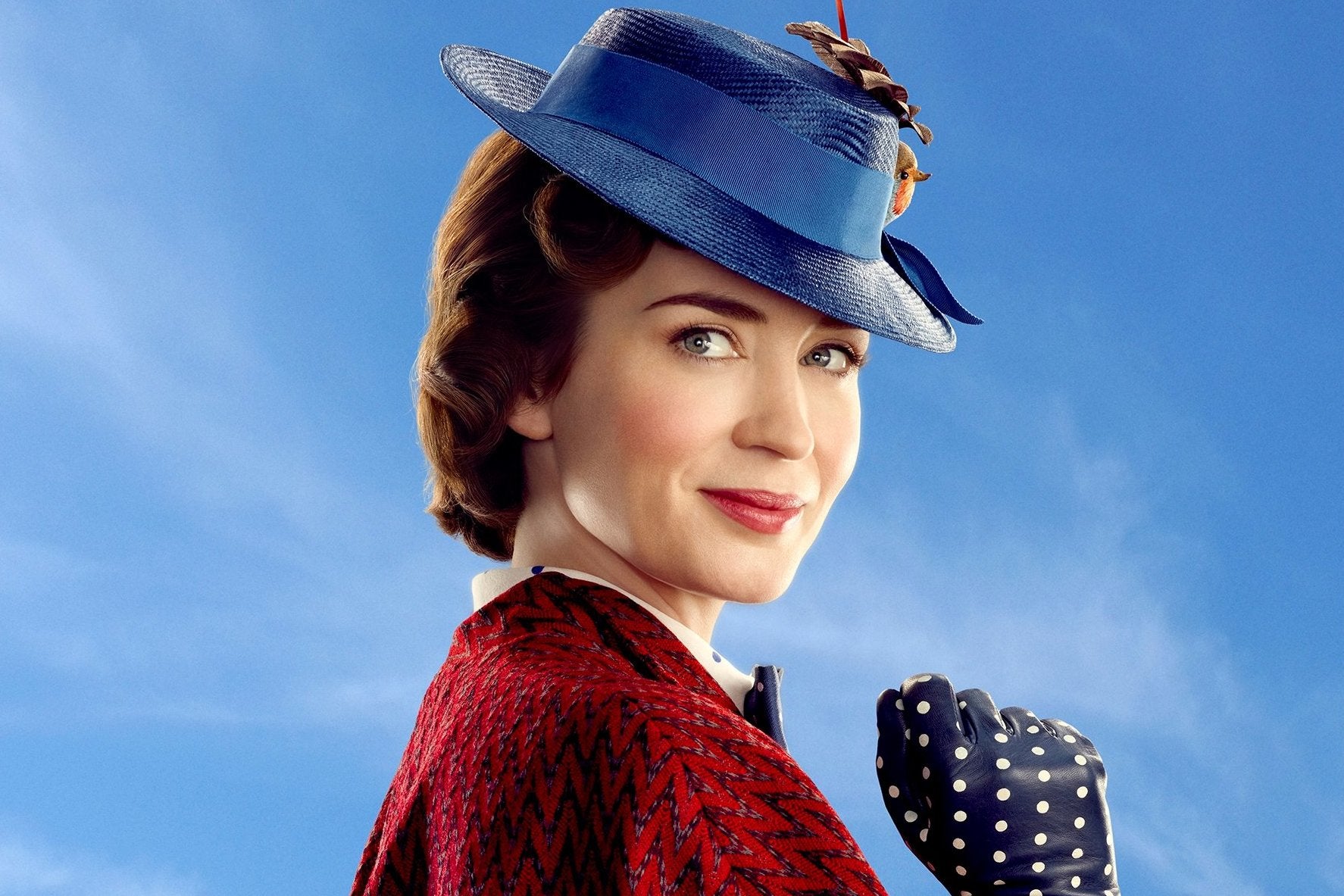In Mary Poppins Returns, Disney's magical nanny has come to save us all
Cast members and the film's director tell Clarisse Loughrey what they thought about Emily Blunt stepping into Julie Andrews's shoes


How do you recapture the feeling of magic? That’s the question the makers of Mary Poppins Returns, the sequel to the 1964 Disney film, had to ask of themselves. We all have our memories of it, from tap-dancing penguins to bottomless carpet bags, but Mary Poppins has also come to exist as a kind of emotional impression. For some, it’s the feeling of faded innocence, of carefree Sunday afternoons sitting in front of the television. For me, it was the promise of a whole new world, as a child moving from the US to the UK, believing the country would be all tea parties on ceilings and kite-flying in the park.
Granted, it didn’t turn out quite as I imagined, but it’s ironic how much a Hollywood musical managed to shape my relationship with where I now call home. And how, sometimes, I can still walk through London and that sudden excitement will rush into my veins. As it turns out, Rob Marshall, the director of Mary Poppins Returns, shares my sentiment. He also finds the city occasionally touched by an indescribable Poppins-tinged magic, since it was the first film he ever saw, aged four. “I see London through those eyes,” he says. “When I come here, I feel that.”
In Mary Poppins Returns, the magical nanny revisits the now-grown Banks children, Jane and Michael, in the 1930s, to once again mend their troubles. It’s a project that not only demanded respect for the first film’s status as a Disney classic, but for the character’s position as a British icon. As much as her Hollywood manifestation has vastly overshadowed her literary origins, the film drawing from the book series by British writer PL Travers, she remains a source of national pride for Britain. It was, after all, a squadron of Poppinses that descended from the heavens to battle Harry Potter’s Lord Voldemort during the Opening Ceremony of London’s 2012 Olympic Games. “I think there’s an intersection in the first film, and in this film, between Britain and Hollywood that is rather delicious,” says Emily Mortimer, who stars in the sequel as Jane Banks. Ben Whishaw, who plays Michael, adds: “I think the marriage of the two is actually very beautiful.”
To be caretaker of such a character is a lot of pressure for any director to handle, but Marshall’s own relationship with the original film made the prospect just as compelling as it was daunting. His first move was to return directly to the source material, Travers’s books, with Mary Poppins Returns taking its greatest inspiration from the second in the series, Mary Poppins Comes Back. As Marshall explains: “We were able to cherry pick the adventures that I thought could be musicalised and turned into set pieces. The books themselves are episodic, so there’s no narrative to them.” He shaped the story with producer John DeLuca and screenwriter David Magee, before composers Marc Shaiman and Scott Wittman then entered the process to commence writing the film’s songs.
“It was a labour of love for me, literally right from my heart,” says Marshall, adding that his goal was to “protect the spirit of the first film and usher in this new, original story”. Both of these aims are beautifully achieved in the casting of Emily Blunt as Mary Poppins. Julie Andrews’s performance has always been key to the 1964 film’s enduring popularity. In the warmth of her laughter, and in the knowingness of her looks, Andrews created a character that could comfort and beguile us in equal measure.
Blunt’s performance is entirely different in its notes – a little more haughty, and drier in her humour – but with exactly the same effect. It’s a performance so perfectly pitched that it’s hard to imagine anyone else in the role. Marshall agrees. The director had only recently wrapped work on his 2014 musical, Stephen Sondheim’s Into the Woods, starring Blunt, when Mary Poppins Returns dropped in his lap. “There wasn’t even half a second of considering anybody else,” he says. “There’s no one else, because the demands of the part are so huge. You know you have to be a great actress to play all those layers of Mary Poppins – there’s the facade of the stern, proper nanny, but underneath there needs to be a beating heart. And she needs to be able to sing and dance. And Emily’s British, so she had everything.”
The actor made a deliberate point of not revisiting the original film, as Marshall adds: “We both realised that you can’t play Julie Andrews, that’s her version of Mary Poppins and she’s iconic and brilliant and will live forever.” Which put the duo in an interesting position. “You know, I always think about – how do you play James Bond? Sean Connery made him so perfect, so you can’t do what Sean Connery did, you have to find your own way in.” For Blunt, the books allowed her to discover new facets to the character, making her own version of Poppins “a bit more eccentric and frickin’ weird” than her predecessor’s.
When it came to Mortimer and Whishaw’s characters, the 1964 film became key to bringing Jane and Michael Banks back to the big screen. “We studied the first movie again,” Mortimer says. “It was really helpful in looking at the children, but also really looking at [their] parents and trying to imagine what it would be like to be the grown-up children of those kind of peculiar people.” Michael may be very different to his stern, serious father – he’s made attempts to become a painter – but he’s ended up on the same pathway, resigned to work at the same bank that employed his father, after falling into dire financial straits following the death of his wife. Jane, meanwhile, has followed in her mother’s suffragette footsteps, working as a labour organiser, helping the poor and unemployed of the city.
There’s no more vivid connection to the first film, however, than the return of Dick Van Dyke. In the original, he played both Bert, the infamously cockney-accented chimney sweep, and Mr Dawes Sr, the head of Fidelity Fiduciary Bank. Here, he plays Mr Dawes Jr, who’s taken over his father’s institution. “It was extraordinary,” Mortimer says of working with Van Dyke. “I mean, talk about a connection to the first film and to the history of Disney. He was sitting in the makeup chair next to me and I couldn’t believe it. He was sitting there talking about the first film and about Walt, who was his friend, and describing the personality of Walt Disney, as this genius, this adult who thought like a child and had the imagination of a child and the sense of joy of a child. And how that was so related to both the first film and this film, too.”

Watch Apple TV+ free for 7 day
New subscribers only. £9.99/mo. after free trial. Plan auto-renews until cancelled.
ADVERTISEMENT. If you sign up to this service we will earn commission. This revenue helps to fund journalism across The Independent.

Watch Apple TV+ free for 7 day
New subscribers only. £9.99/mo. after free trial. Plan auto-renews until cancelled.
ADVERTISEMENT. If you sign up to this service we will earn commission. This revenue helps to fund journalism across The Independent.

Van Dyke provided a connection not only to the history of Walt Disney Studios, but also to the movie musical’s glorious past. And Mary Poppins Returns, in a way, is a tribute to both these aspects, and to a time where musicals dominated the film landscape. “I’ve always wanted to do an original musical for film, because my favourite musicals are the ones that were created for film from the great MGM era, like Singin’ in the Rain, Bandwagon, and Meet Me in St Louis,” Marshall says. Not only is this his first musical not adapted from a Broadway show, like past efforts Chicago and Nine, it’s part of a small wave of original, live-action musicals hitting cinemas, alongside La La Land and The Greatest Showman. Their release has started to fill what, for years, has been a notable void in the cinematic landscape.
Why the boost? In short, we live in difficult times, and the movie musical has always existed as a kind of temporary balm. “The big movie musical really grew out of the Depression era, where people needed to be comforted and lifted by what it can bring,” Marshall says. “There’s nothing like a musical to lift your soul.” Mary Poppins Returns reflects this in a surprisingly direct way, since the film flashes forward to the 1930s, and the era of the Great Depression itself, so that it can bring the musical’s message of hope to its very heart.
“The first thing I did was I went directly to the book and saw that they were written in the Depression era,” Marshall says. “And what I found is that you really feel the Depression era in the books, even though it’s very subtle. PL Travers will say something about the bank being broken, or that 17 Cherry Tree Lane was the shabbiest house on the street, and that Mrs Banks had a choice of fixing up the house or having children. I thought it was so timely to set it in the 1930s, because it feels much more accessible to me now, about people struggling to hold onto a home or struggling to make ends meet.”
The film opens on the bank threatening to foreclose on Michael and Jane’s childhood home, as Whishaw explains: “When we meet these characters, they’ve gone through some compromise and some hardship and some loss. Real life has invaded,” he says. In fact, Marshall believes this is mostly why Poppins makes her return, for Michael’s sake more than for his three children (played by Pixie Davies, Nathanael Saleh, and Joel Dawson). “You put away childish things and the realities of life set in and you have to deal with that,” Marshall says. “She comes back to help reignite that sense of being a child again. I think we all need to remember that inner child inside, that fresh sense of wonder and imagination. I mean, how else do you move forward with life?” For those behind the film, Mary Poppins hasn’t merely come back to save the Banks family, she’s come back to save us all.
Mary Poppins Returns is released in UK cinemas on Friday 21 December

Join our commenting forum
Join thought-provoking conversations, follow other Independent readers and see their replies
Comments
Bookmark popover
Removed from bookmarks